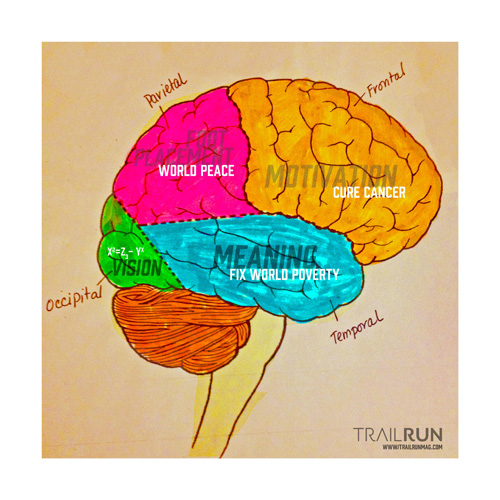“Our search for understanding will never come to an end, and…we will always have the challenge of new discovery. Without it, we would stagnate.” – Stephen Hawking
I remember reading somewhere that some (many?) of the world’s most brilliant minds were and are runners. Not Stephen Hawking, obviously. But others of his ilk more fortunate in physical capacity.
Not only that, but when faced with one of their mind boggling problems – like, how do black holes work and is the universe expanding or contracting, that kind of thing – it was a run that emptied their obviously fruitfully full minds enough for them to see the light (or the dark in the case of black holes and dark matter) and solve the problem.
Sure, some people sit on the toilet for their lightbulb moments. Others take LSD. (LSD perhaps scatters the mental decks and a restroom stink is perhaps not the best olfactory seed for genius). I reckon it’s on the run where the brain best expunges the clutter, readies for clarity and follows the legs’ lead to go into overdrive.
It may be in a manner that dreams up your next creative vision (talking to all you painters, potters and rainbow makers). It may be a mathematical solution that you break the back of (talking to all you PhD physicists reading). Or it may just be cracking that damn Sudoku in last weekend’s newspaper (hi, Mum). But I bet you’ve had some kind of brainwave hit you on the trail (sometimes a second before the tree branch knocks it out of you, the distraction of your own brilliance momentarily making you forget to duck).
There’s some science behind why any scientist worth their weight in Nobel Prizes runs. Partly it’s about your Chief Executive Officer. That’s colloquial for the prefrontal cortex of your brain that they reckon steer the intelligence ship. It is the area just behind our foreheads that controls the “executive functioning”, which includes cognitive processes like prioritising, planning, initiating, managing working memory, managing time and resources, and self-regulation.
The results of a study by Hillman and his fellow boffins1 suggest that intense cardiovascular exercise affects neuro-electric processes that underpin executive control. Simply, exercise improves your ability to manage cognitive processeses.
 Another report2 reckons that aerobic exercise training has antidepressant and anxiolytic (something that inhibits anxiety) effects, which protect against the harmful consequences of stress. The findings suggest that exercise triggers a process that helps not only endure and reverse, but prevent future stress.
Another report2 reckons that aerobic exercise training has antidepressant and anxiolytic (something that inhibits anxiety) effects, which protect against the harmful consequences of stress. The findings suggest that exercise triggers a process that helps not only endure and reverse, but prevent future stress.
And of course we all know and love the ‘runners’ high’, a euphoria felt after running described by as the so-called opioid theory. Boeker et al3 suggests region-specific effects in the frontolimbic brain area that translate to improved mood and an increase in general optimism.
Right, so running means that our brains work better, we stave off feeling down and indeed we get a little high. How does that translate into Eureka moments?
One factor is simply that with better delivery of oxygen and energy to the brain – it works better. Exercise increases cerebral blood flow and provides for more efficient glucose utilisation. Writes Craig Bennett, a postdoctoral researcher in the Department of Psychology at the University of California, Santa Barbara, (and a runner): “The brain lives on glucose. Over 25% of the energy you take in is going to fuel that grey matter in your skull. When you are really working (thinking) on a tough problem that percentage only goes up as energy usage increases. If you can more efficiently get energy where it needs to go that would represent a major benefit to cognitive processing.”
Indeed, make a rat run in a laboratory and it gets smarter. Make it run harder than it otherwise might have of its own volition, and its thinking prowess improves further.
Of course, it is the act of running in the first place that some argue (including Christopher McDougall of Born to Run fame who most popularly leads the charge) led to mankind’s sudden warp speed increase in intelligence: we ran animals to death, ate the meat, our brains exploded with the protein pill leading to vastly improved cognitive functions and outcomes, like agriculture, politics and One Direction.
So where does this leave us? Firstly, that running should be incorporated into our education system, primary, secondary and tertiary. Post doctorate in quantum mechanics? You’ll be up for an ultra distance, then. Secondly: running (or some form of physical activity that is cardio vascular intensive) should be prescribed by doctors and psychologists more often than drugs – the science is in, the former can be just as if not more effective than the latter (obviously cautioned by a dose of context here – I’m not saying a psychopathic prone to bodily harm should simply be told to go for a jog). Finally: it doesn’t always work. After all, (Australian Prime Minister) Tony Abbott runs a lot and it doesn’t seem to laying the groundwork for any Eureka moments there.
And so, as Stephen Hawking said “…our search for understanding will never come to an end…” Better keep on running then. The answers – whatever the problem – are out there. On the trail.
 Chris Ord, Australian Editor
Chris Ord, Australian Editor
chris (at) trailrunmag.com
[THIS EDITORIAL – ALONG WITH THOSE OF THE ASIA AND NEW ZEALAND EDITORS – APPEARS IN the LATEST EDITION (11) OF TRAIL RUN MAG. GET YOUR COPY HERE.]
1. Charles H. Hillman, Erin M. Snook, and Gerald J. Jerome. (2003) Acute cardiovascular exercise and executive control function. International Journal of Psychophysiology, 48 (3), pp. 307-314.
2. Salmon, Peter. (2001) Effects of physical exercise on anxiety, depression, and sensitivity to stress: A unifying theory. Clinical Psychology Review, 21(1), pp. 33–61.
3. Henning Boecker, Till Sprenger, Mary E. Spilker, Gjermund Henriksen, Marcus Koppenhoefer, Klaus J. Wagner, Michael Valet, Achim Berthele and Thomas R. Tolle. (2008) The Runner’s High: Opioidergic Mechanisms in the Human Brain, Cerebral Cortex, 18 (3), pp. 2523-2531.








